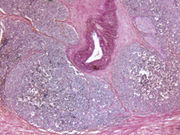Achieves an 82 percent rate of absent clinically significant cancer in treated lobes
TUESDAY, July 25, 2017 (HealthDay News) — For men with low-risk prostate cancer, vascular targeted photodynamic therapy achieves an 82 percent rate of absent clinically significant cancer in treated lobes, according to a study published in the August issue of The Journal of Urology.
Souhil Lebdai, M.D., from the University Hospital of Angers in France, and colleagues followed 82 men treated with vascular targeted photodynamic therapy for low-risk prostate cancer every six months. Six months after treatment or when there was biological or clinical progression, patients underwent prostate biopsies.
Patients were followed for a median of 68 months. The researchers found that median progression-free survival was 86 months. Six months after treatment, there was a significant 41 percent decrease in median prostate-specific antigen, which remained stable during follow-up (P < 0.001). One hundred fifteen lobes were treated and 82 percent achieved absent clinically significant cancer. Twenty of the patients (24 percent) underwent radical therapy, including 18 and two patients who underwent radical prostatectomy and brachytherapy, respectively, at a median of 22 months.
“Padeliporfin vascular targeted photodynamic therapy for low-risk prostate cancer achieved an 82 percent rate of absent clinically significant cancer in treated lobes and 76 percent of patients avoided radical therapy at a median follow-up of 68 months,” the authors write. “However, longer term follow-up is required to determine long-term outcomes.”
One author disclosed financial ties to Steba Biotech, which funded the study.
Copyright © 2017 HealthDay. All rights reserved.








